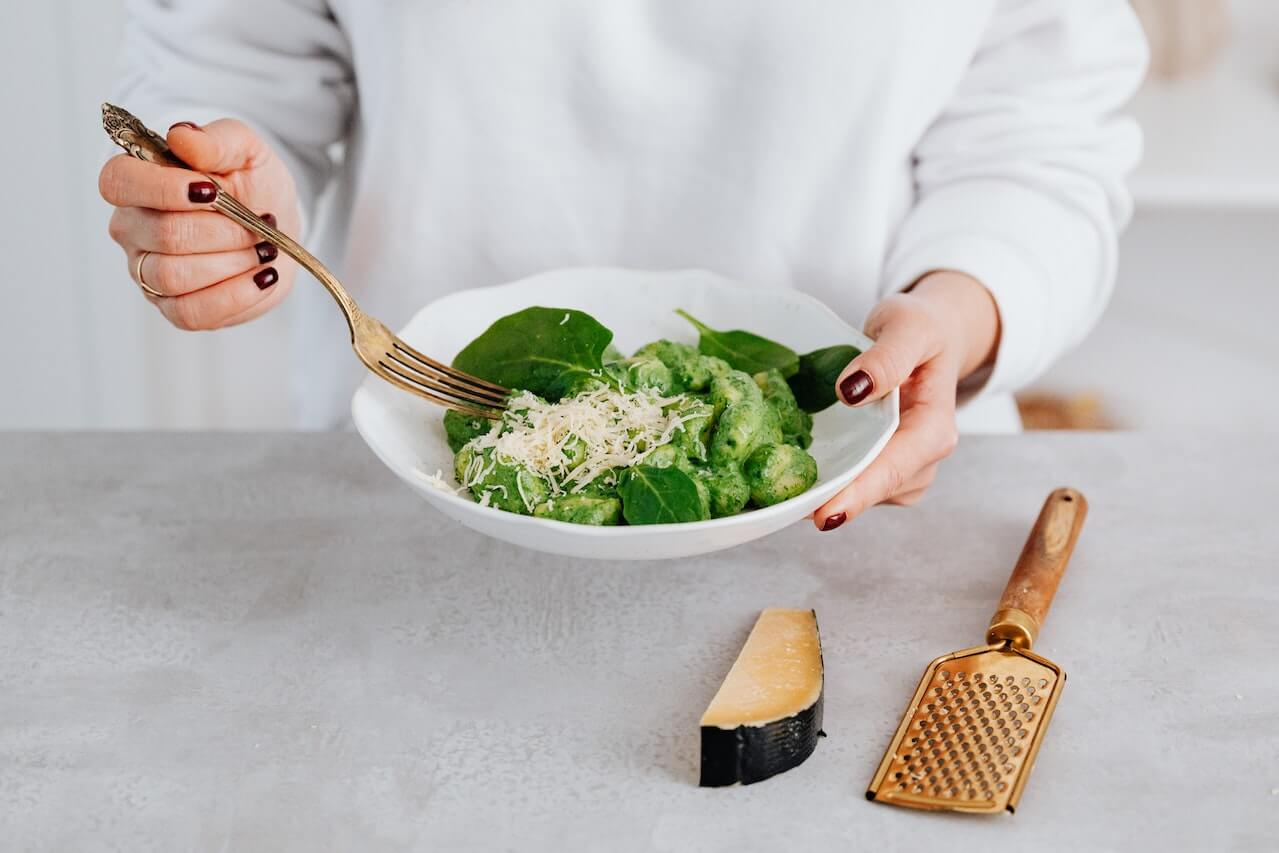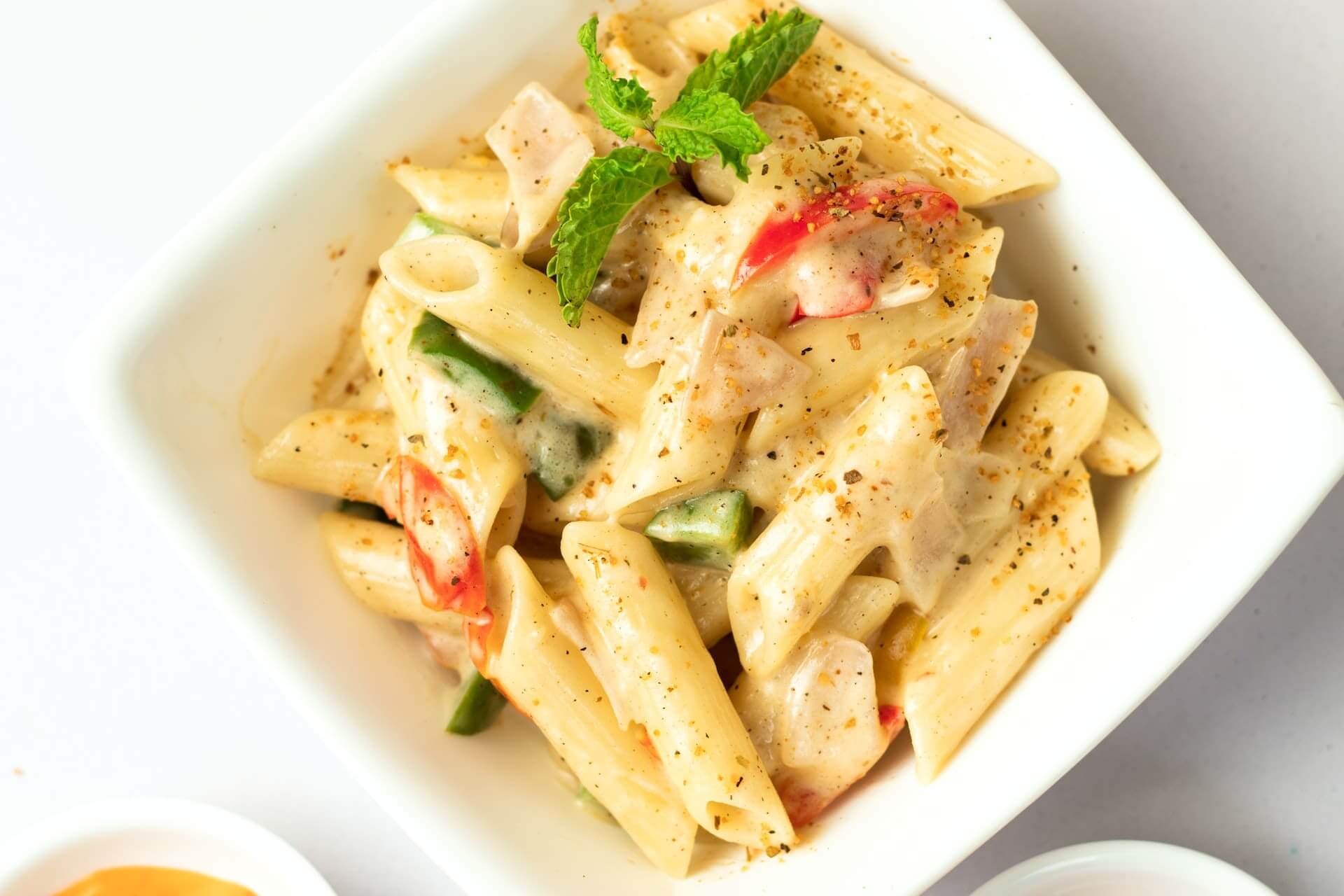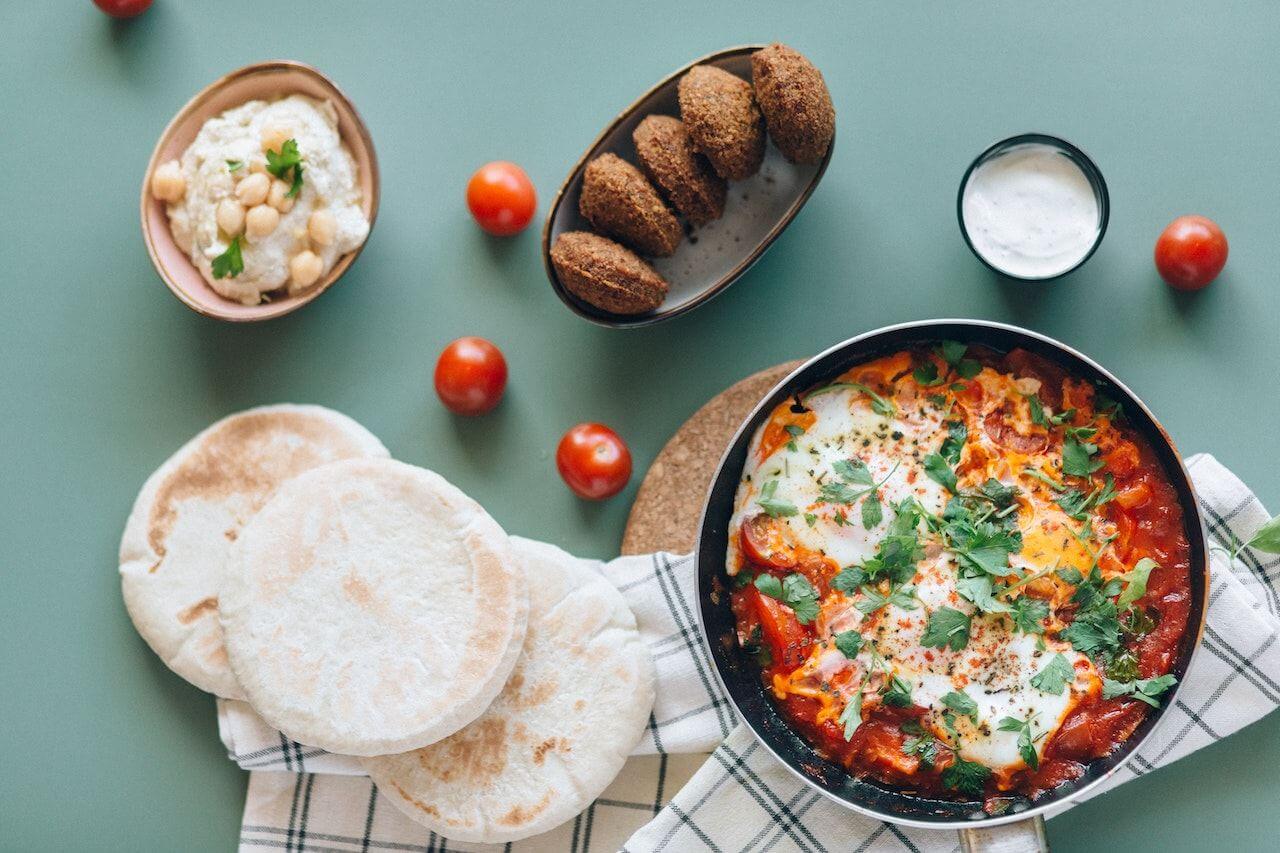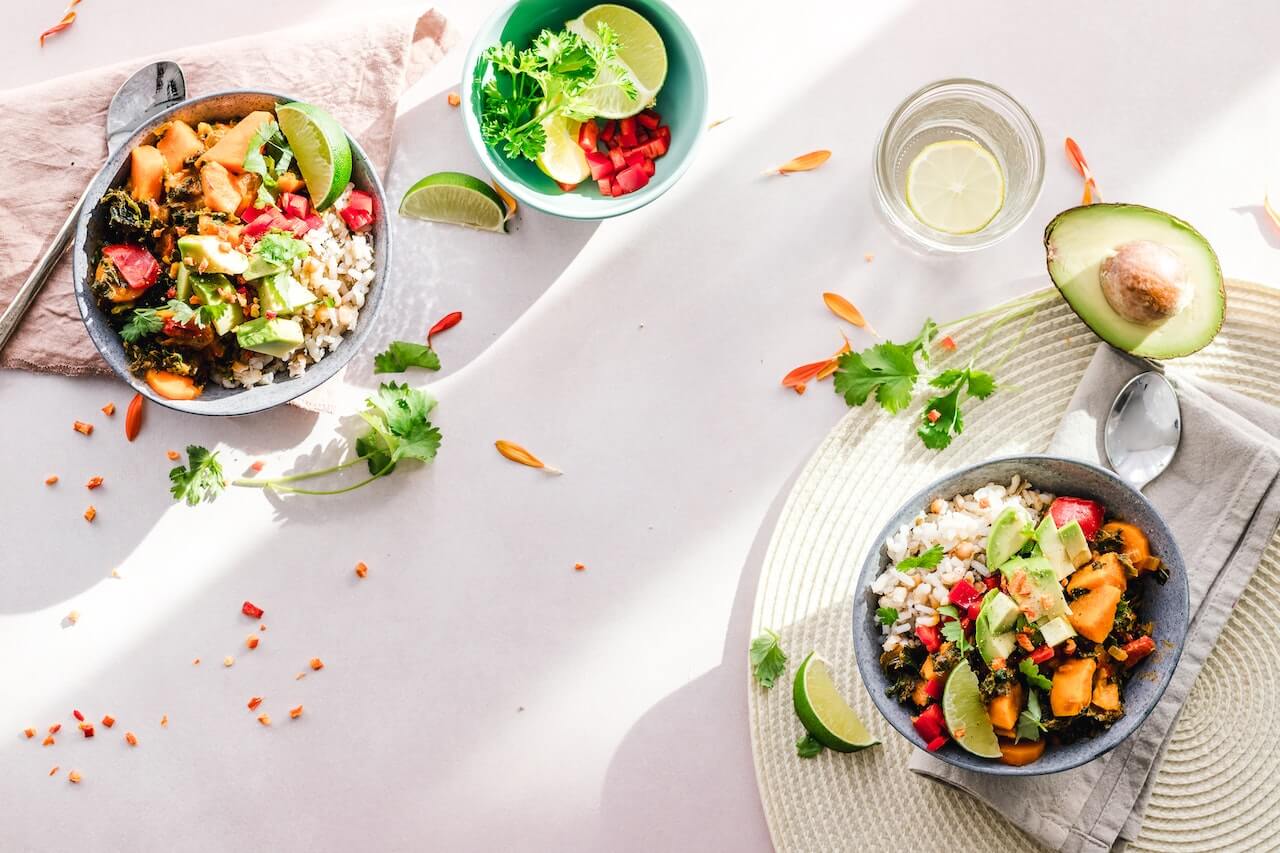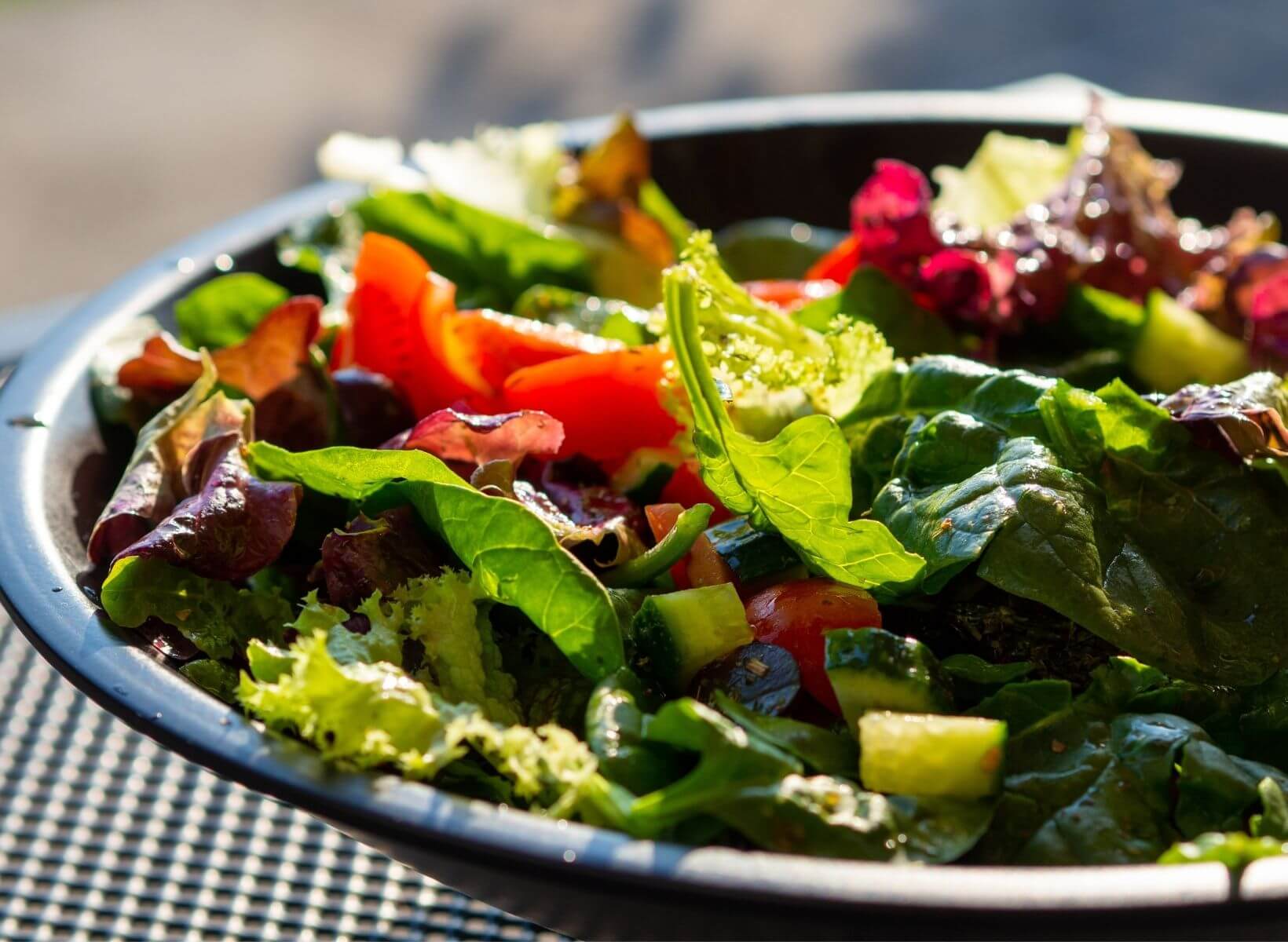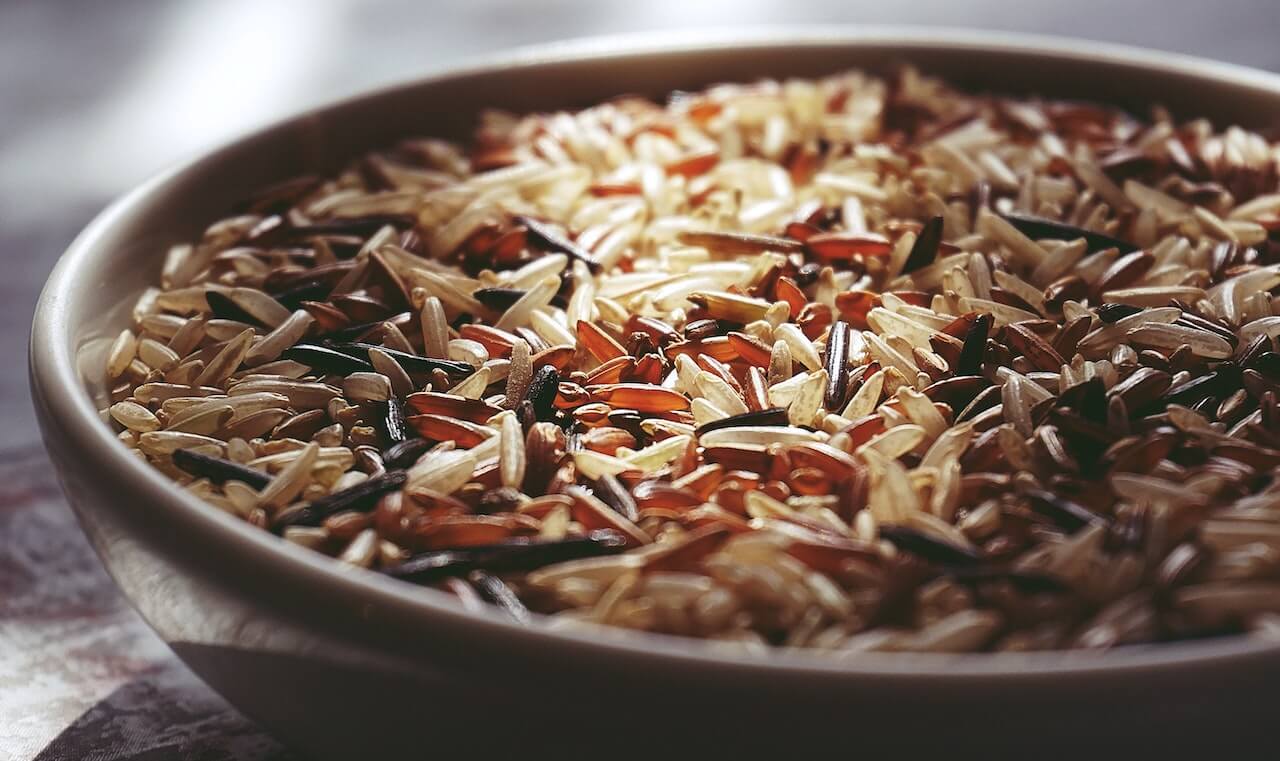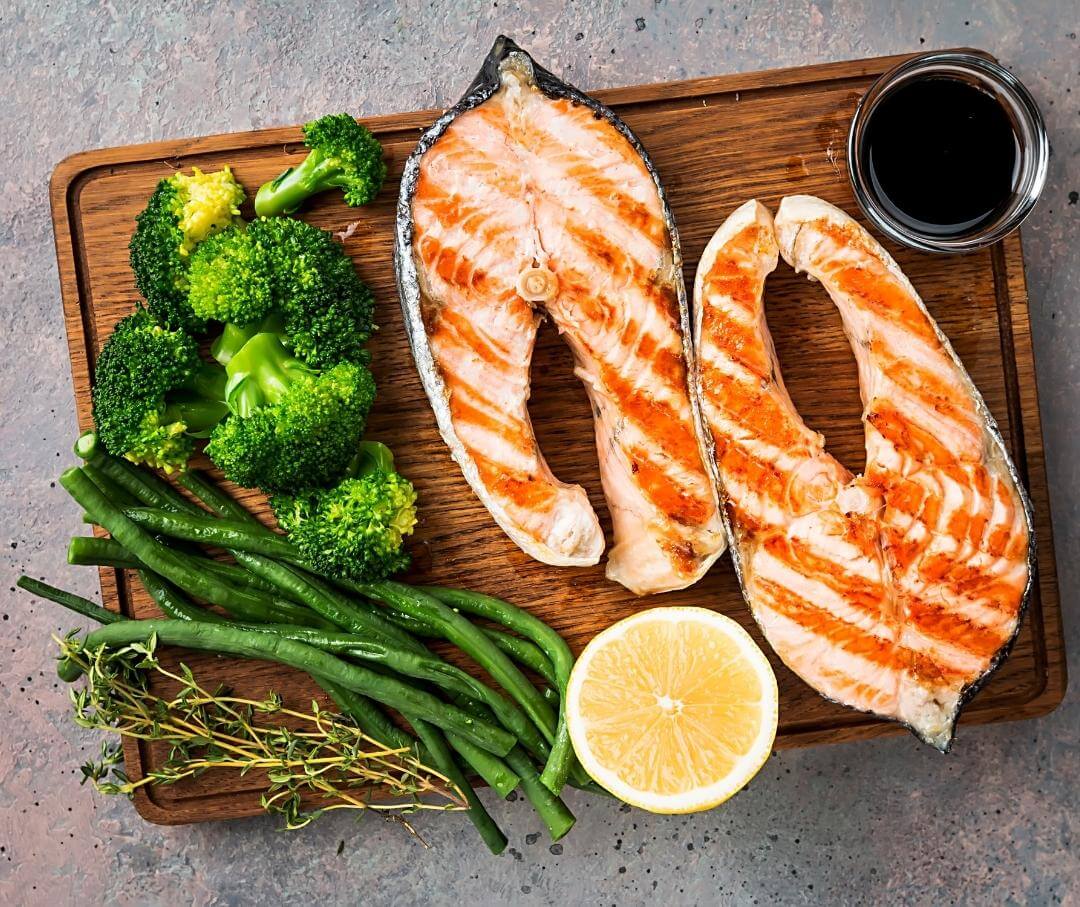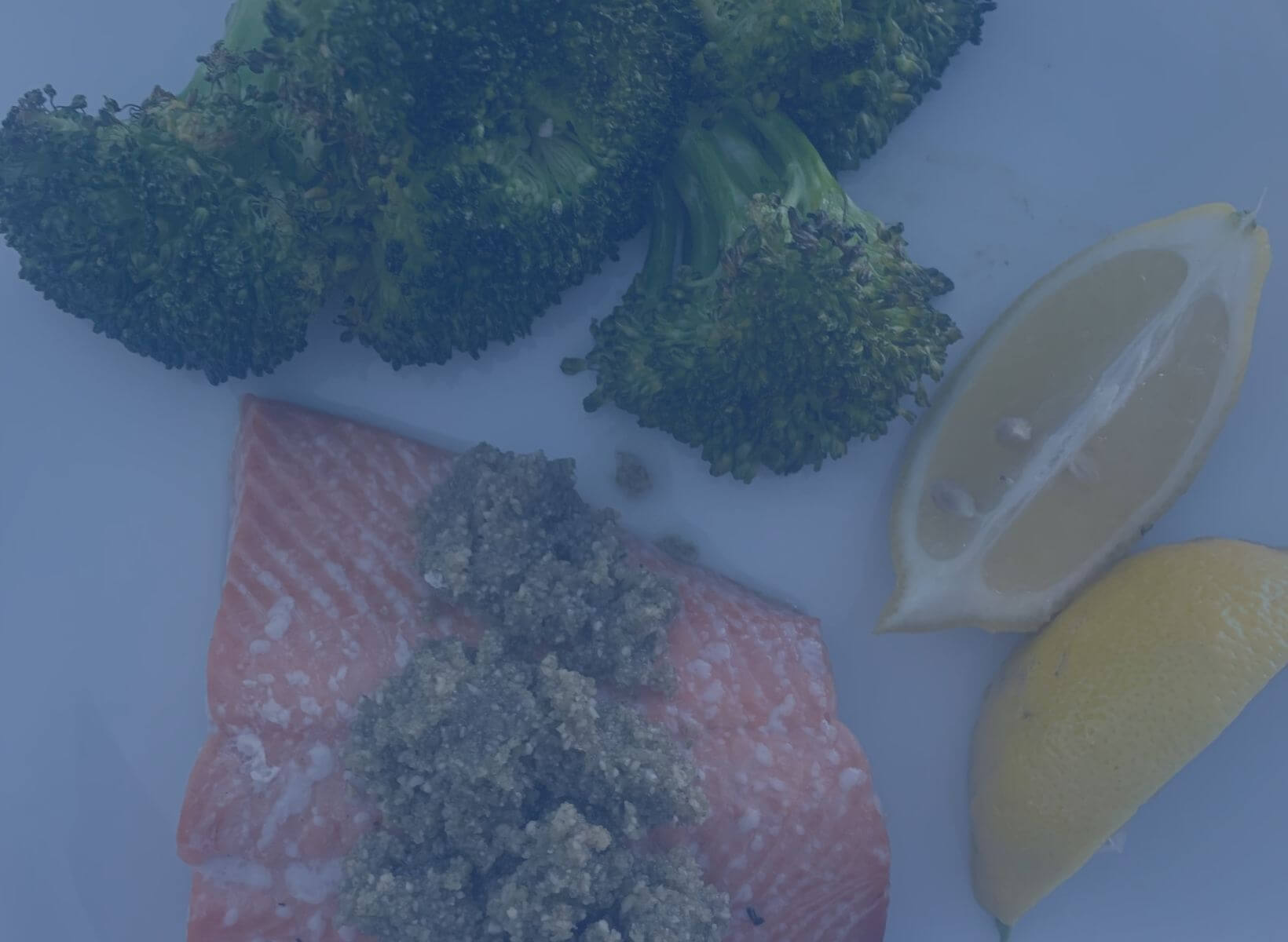Pesto is a vibrant green sauce used in Mediterranean cooking. It’s versatile and delicious, but somewhere between the push for fat-free everything in the nineties and contemporary nutritional trends, it lost its reputation as a healthy food.
In reality, pesto contains nutrients to support health and can be part of a diet to support a healthy weight. The trick (as with nearly everything else in the nutrition world) is to keep tabs on portions and balance it out with other nutrient-dense foods.
In this article, you’ll find all you need to know about pesto—including different varieties, benefits, and delicious recipes you can add to your weekly meal rotation.
What is Pesto?
Marinara sauce may be your go-to for pasta dishes but don’t forget about pesto. This bright green, fragrant sauce comes from Italian kitchens dating back to Roman times. Pesto’s versatility means you don’t have to limit it to dishes with noodles—it also makes a fantastic sauce or marinade for poultry, fish, and veggies.
Most people no longer have a mortar and pestle in their kitchen (these tools were used to make pesto traditionally), but it’s surprisingly simple to make the sauce in a blender or food processor. A basic pesto sauce usually contains the following:
- Fresh basil
- Extra virgin olive oil
- Parmesan cheese
- Raw garlic
- Pine nuts
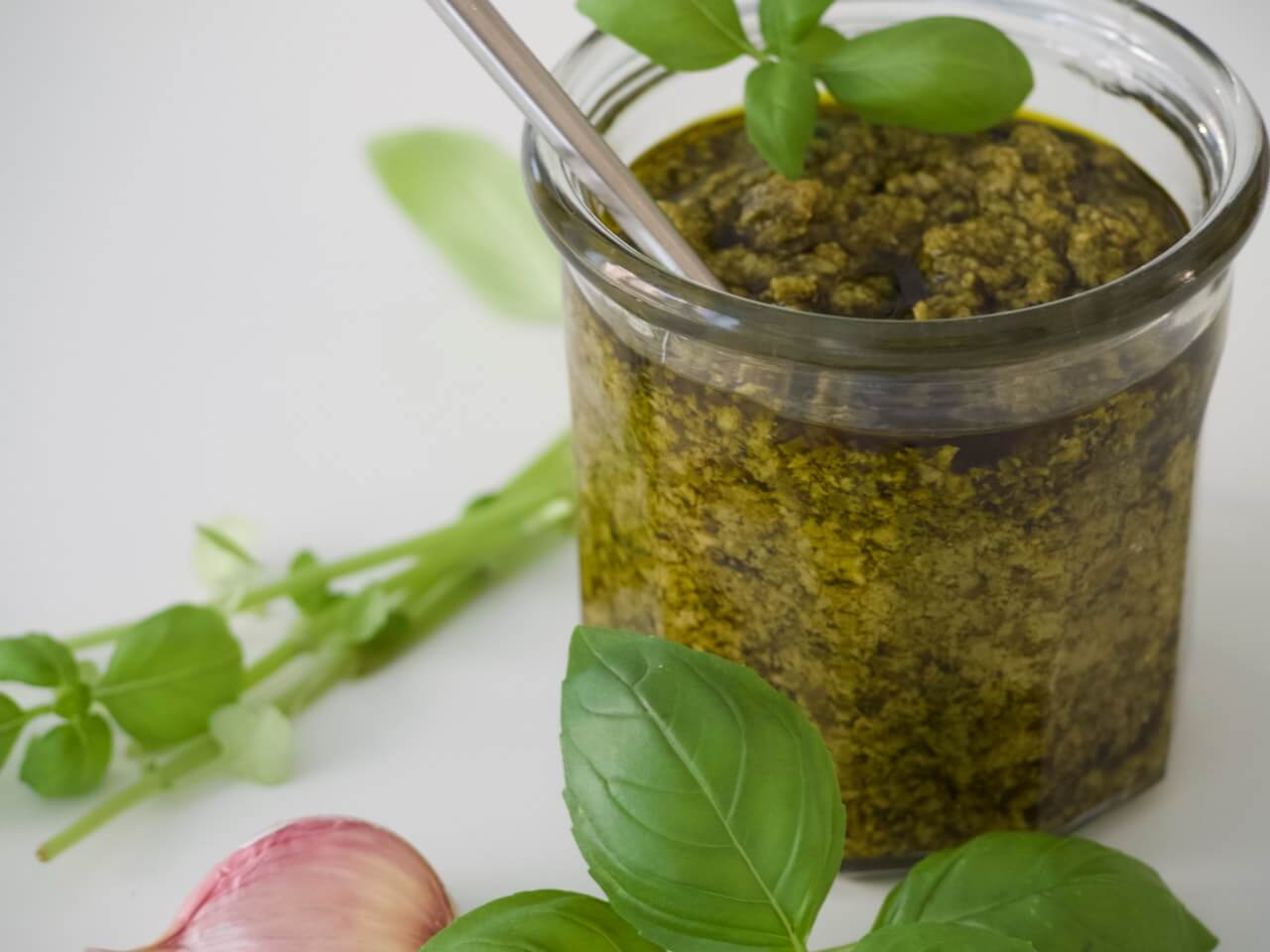
Pesto Nutrition Facts
According to the USDA, a quarter-cup serving of fresh, refrigerated pesto contains the following nutrients:¹
- Calories: 263
- Protein: 6 grams
- Fat: 24 grams
- Carb: 6 grams
- Fiber: 1 gram
- Sugar: 4 grams
Pesto nutrition facts will differ depending on whether it is store-bought, homemade, shelf-stable, or refrigerated. For example, if you make pesto at home, you have more control over how much salt you add or the type of oil. Extra virgin olive oil is the usual choice, but some brands may use different vegetable oils to reduce costs.
Pesto also contains other essential nutrients like antioxidants and omega-3 fatty acids from basil, nuts, and olive oil, and vitamins and minerals from all the ingredients.
Since pesto is naturally low in carbohydrates, it’s considered a low glycemic index (GI) food, making it less likely to cause a spike in blood sugar levels.
Types of Pesto
Traditional pesto uses fresh basil leaves and pine nuts, but there are plenty of ways to mix it up and create variations you enjoy. Creativity is encouraged in the kitchen, so don’t feel limited to the ingredients above. Here are some delicious variations:
- Swap leafy greens like kale or arugula for basil (or use half each).
- Use walnuts instead of pine nuts to boost omega-3 content.
- Add sundried tomatoes or artichoke hearts to the mix.
- Try other herbs like oregano, or give it a spicy shot of cilantro.
- Add lemon juice for a zesty kick.
- Make it vegan and use nutritional yeast instead of parmesan cheese.
- Leave out the nuts entirely for those who can’t eat them.
If you make pesto at home, stick with high-quality extra virgin olive oil for the health benefits and aromatic flavor.
4 Health Benefits of Pesto
- Antioxidant properties. The Mediterranean diet is so powerful for health because it contains high amounts of antioxidants—especially from olive oil. Antioxidants are compounds that neutralize free radicals, reactive molecules that can cause oxidative damage to tissues and cells.
Oxidative damage is linked to inflammation and chronic disease risk, but pesto boosts antioxidants to fight back.² Olive oil contains polyphenols that exert high antioxidant activity in the body.³ Basil, nuts, and garlic are also antioxidant powerhouses, contributing to the total load of antioxidants in pesto.⁴
- Heart health. Once again, the nutritional profile of olive oil may provide cardiovascular protection. Mono- and polyunsaturated fats found in olive oil are linked to healthy cholesterol levels and may increase HDL (protective) cholesterol in the body.⁵
Oleuropein, a polyphenol found in olive oil, may also help protect blood vessels against oxidative damage.⁶ Garlic also has heart-protective properties and is well-researched for its positive impact on blood pressure.⁷
- Blood sugar. In addition to being a low GI food, oleuropein from the olive oil in pesto may support the health of beta cells which produce insulin.6 Insulin is the hormone that lowers blood sugar, and oleuropein is also associated with improved insulin sensitivity (how well your cells respond).⁸
Olive oil is associated with a significantly lower risk of type 2 diabetes, according to a meta-analysis of 29 research trials.⁹ Garlic is also linked to better blood sugar control.¹⁰ Of course, if you eat pesto with large portions of white pasta, blood sugar may rise (depending on your response). Still, pesto could benefit blood sugar in appropriate amounts when combined with other supportive foods.
- Cognitive health. Studies on the Mediterranean diet and brain health show a positive relationship, where the healthy fats from olive oil may support brain function and memory.¹¹ Antioxidants are an essential part of the equation as they can reduce the risk of oxidative stress that contributes to age-related cognitive decline.¹²
Interestingly, the antioxidants in garlic may also support brain health. Research suggests that garlic may have neuroprotective properties, meaning it could help protect brain cells against damage linked to cognitive decline and dementia.¹³
{{mid-cta}}
2 Potential Downsides
The downsides to including pesto in your diet are minimal, but there are two to consider. First, since traditional pesto contains nuts, someone with a nut allergy must avoid traditionally prepared recipes. Luckily, there’s an easy workaround using recipes without nuts.
Second, store-bought pesto may or may not contain extras you may not want to eat. Extra sugar, salt, or preservatives are all common in store-bought sauces. You can avoid this by making the pesto yourself or double check your ingredients for store-bought items.
Is Pesto Good for Weight Loss?
Given all of the above, pesto can undoubtedly be considered a healthy food, and as long as you keep track of portions, it can also be part of a diet that supports a healthy weight.
Pesto is nutrient-dense, and because of its fat content, it’s also calorically dense. Calorically dense foods provide a lot of calories in a small serving—think nuts, seeds, and oils. There’s no need to avoid these foods, but if overall calories are something you’re watching, you may want to keep track of the amount you’re eating.
Luckily a little pesto goes a long way, so you won’t need to use much to add flavor to your dish. Interestingly, studies suggest that people who include olive oil in their diet tend to have a lower BMI (and a lower risk of dying from any cause) than those who don’t.¹⁴ As with all foods, the key is balance and moderation.
<p class="pro-tip"><strong>Learn more: </strong> <a href="/blog/salmon-and-broccoli-with-pumpkin-seed-pesto">Salmon and Broccoli With Pumpkin Seed Pesto</a>.</p>
How to Prepare Healthy Pesto at Home
Making pesto at home requires a few simple tools and ingredients. Use the following recipe to get started. Once you’ve got the basics down, try using some of the swaps above to create your favorite version.
Ingredients:
- 2 cups fresh basil leaves, washed and dried
- ½ cup extra-virgin olive oil
- ¼ cup grated parmesan cheese
- 2 garlic cloves, peeled and crushed
- ¼ cup pine nuts
- ¼ tsp. sea salt
Instructions:
- Place all ingredients in a food processor or blender and blend until combined.
- Taste and adjust seasoning as needed.
- Place pesto in an airtight container or jar and store in the refrigerator for up to 1 week.
4 Healthy Pesto Recipes
High Fiber Pesto Pasta
Ingredients:
- 2 cups cooked lentil or garbanzo pasta
- ½ cup pesto
- 1/3 cup roasted red peppers, chopped
- 1/3 cup feta cheese, crumbled
Instructions:
- Add cooked pasta to a large bowl.
- Pour pesto over the pasta and toss to combine.
- Add roasted red peppers and feta cheese, and stir to incorporate.
- Serve warm.
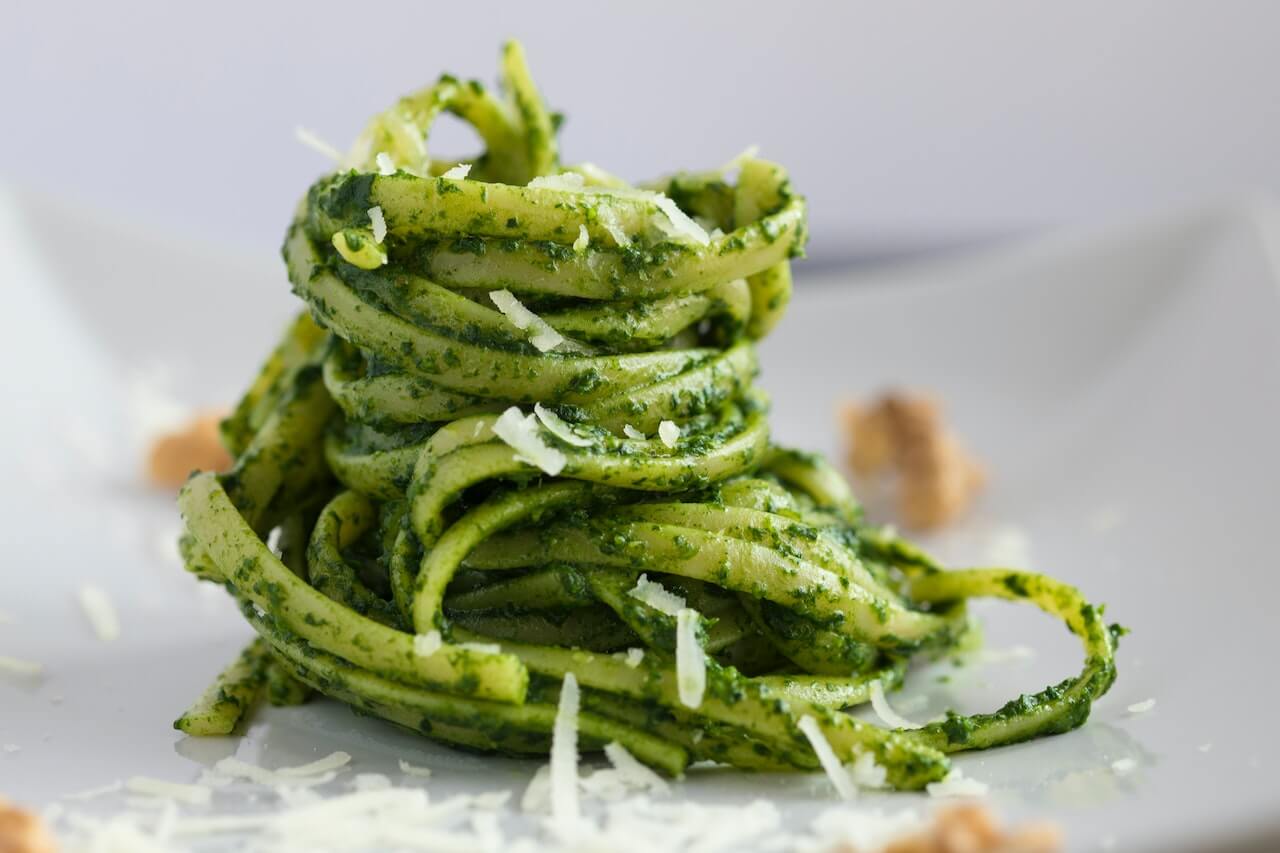
Kale Pesto Salad
Ingredients:
- 3 cups kale, chopped
- ¼ cup pesto
- 1/3 cup dried cranberries
- ½ cup feta cheese, crumbled
Instructions:
- Place kale in a large bowl and drizzle with pesto.
- Massage the pesto into kale leaves until evenly distributed.
- Add cranberries and feta cheese, and toss to combine.
- You can eat immediately or put the salad in the fridge for a few hours before serving to allow the flavors to marinate.
Baked Pesto Chicken with Greens
Ingredients:
- 2 chicken breasts, boneless and skinless
- ¼ cup pesto
- 1 tsp. garlic powder
- ½ cup kale, chopped
Instructions:
- Preheat the oven to 350°F.
- Place chicken breasts on a baking sheet and season with garlic powder.
- Spread pesto over chicken and bake in preheated oven for 15-20 minutes.
- Add kale to the pan and bake for 10 minutes or until the chicken reaches an internal temperature of 165°F.
- Serve warm.
Pesto Roasted Vegetables
Ingredients:
- 1 zucchini, sliced into rounds
- 1 yellow squash, sliced into rounds
- 1 red pepper, chopped
- 2 Tbsp. pesto
Instructions:
- Preheat oven to 375°F.
- Place sliced zucchini, squash, and chopped red pepper on a baking sheet.
- Drizzle with pesto and toss to combine.
- Bake in preheated oven for 20-25 minutes, until vegetables are tender.
- Serve warm.
<p class="pro-tip"><strong>Keep reading: </strong> <a href="/blog/healthy-pasta-recipes">20 Healthy & Delicious Pasta Recipes You’ll Love</a>.</p>
Learn More About Nutrition and Healthy Eating with Signos’ Expert Advice
Pesto is a nutrient-dense food with lots of health benefits, but each person may respond differently. When tracking metabolic health, Signos uses immediate feedback from a continuous glucose monitor (CGM) to help recommend food choices that better align with your health goals. You may find pesto pasta spikes your blood sugar, but adding pesto to a salad or using it as a flavoring on chicken keeps works better for your body.
By helping you understand how your body responds to different types of foods, Signos can provide more tailored nutrition advice than any generic diet plan. Find out if Signos is a good fit for your lifestyle by taking a quick quiz here.
- Item 1
- Item 2
- item 3
Topics discussed in this article:
References
1. USDA (n.d) Food Data Central. (Retrieved March 27th, 2023): https://fdc.nal.usda.gov/fdc-app.html#/food-details/171579/nutrients
2. Sharifi-Rad, M., Anil Kumar, N. V., Zucca, P., Varoni, E. M., Dini, L., Panzarini, E., Rajkovic, J., Tsouh Fokou, P. V., Azzini, E., Peluso, I., Prakash Mishra, A., Nigam, M., El Rayess, Y., Beyrouthy, M. E., Polito, L., Iriti, M., Martins, N., Martorell, M., Docea, A. O., Setzer, W. N., … Sharifi-Rad, J. (2020). Lifestyle, Oxidative Stress, and Antioxidants: Back and Forth in the Pathophysiology of Chronic Diseases. Frontiers in physiology, 11, 694. https://doi.org/10.3389/fphys.2020.00694
3. Kalogeropoulos, N., & Tsimidou, M. Z. (2014). Antioxidants in Greek Virgin Olive Oils. Antioxidants (Basel, Switzerland), 3(2), 387–413. https://doi.org/10.3390/antiox3020387
4. Carlsen, M. H., Halvorsen, B. L., Holte, K., Bøhn, S. K., Dragland, S., Sampson, L., Willey, C., Senoo, H., Umezono, Y., Sanada, C., Barikmo, I., Berhe, N., Willett, W. C., Phillips, K. M., Jacobs, D. R., Jr, & Blomhoff, R. (2010). The total antioxidant content of more than 3100 foods, beverages, spices, herbs and supplements used worldwide. Nutrition journal, 9, 3. https://doi.org/10.1186/1475-2891-9-3
5. Guasch-Ferré, M., Hu, F. B., Martínez-González, M. A., Fitó, M., Bulló, M., Estruch, R., Ros, E., Corella, D., Recondo, J., Gómez-Gracia, E., Fiol, M., Lapetra, J., Serra-Majem, L., Muñoz, M. A., Pintó, X., Lamuela-Raventós, R. M., Basora, J., Buil-Cosiales, P., Sorlí, J. V., Ruiz-Gutiérrez, V., … Salas-Salvadó, J. (2014). Olive oil intake and risk of cardiovascular disease and mortality in the PREDIMED Study. BMC medicine, 12, 78. https://doi.org/10.1186/1741-7015-12-78
6. Gorzynik-Debicka, M., Przychodzen, P., Cappello, F., Kuban-Jankowska, A., Marino Gammazza, A., Knap, N., Wozniak, M., & Gorska-Ponikowska, M. (2018). Potential Health Benefits of Olive Oil and Plant Polyphenols. International journal of molecular sciences, 19(3), 686. https://doi.org/10.3390/ijms19030686
7. Varshney, R., & Budoff, M. J. (2016). Garlic and Heart Disease. The Journal of nutrition, 146(2), 416S–421S. https://doi.org/10.3945/jn.114.202333
8. de Bock, M., Derraik, J. G., Brennan, C. M., Biggs, J. B., Morgan, P. E., Hodgkinson, S. C., Hofman, P. L., & Cutfield, W. S. (2013). Olive (Olea europaea L.) leaf polyphenols improve insulin sensitivity in middle-aged overweight men: a randomized, placebo-controlled, crossover trial. PloS one, 8(3), e57622. https://doi.org/10.1371/journal.pone.0057622
9. Schwingshackl, L., Lampousi, A. M., Portillo, M. P., Romaguera, D., Hoffmann, G., & Boeing, H. (2017). Olive oil in the prevention and management of type 2 diabetes mellitus: a systematic review and meta-analysis of cohort studies and intervention trials. Nutrition & diabetes, 7(4), e262. https://doi.org/10.1038/nutd.2017.12
10. Choudhary, P. R., Jani, R. D., & Sharma, M. S. (2017). Effect of Raw Crushed Garlic (Allium sativumL.) on Components of Metabolic Syndrome. Journal of Dietary Supplements, 15(4), 499–506. https://doi.org/10.1080/19390211.2017.1358233
11. Valls-Pedret, C., Sala-Vila, A., Serra-Mir, M., Corella, D., de la Torre, R., Martínez-González, M. Á., Martínez-Lapiscina, E. H., Fitó, M., Pérez-Heras, A., Salas-Salvadó, J., Estruch, R., & Ros, E. (2015). Mediterranean Diet and Age-Related Cognitive Decline: A Randomized Clinical Trial. JAMA internal medicine, 175(7), 1094–1103. https://doi.org/10.1001/jamainternmed.2015.1668
12. Aridi, Y. S., Walker, J. L., & Wright, O. R. L. (2017). The Association between the Mediterranean Dietary Pattern and Cognitive Health: A Systematic Review. Nutrients, 9(7), 674. https://doi.org/10.3390/nu9070674
13. Mathew, B., & Biju, R. (2008). Neuroprotective effects of garlic a review. The Libyan journal of medicine, 3(1), 23–33. https://doi.org/10.4176/071110
14. Guasch-Ferré, M., Li, Y., Willett, W. C., Sun, Q., Sampson, L., Salas-Salvadó, J., Martínez-González, M. A., Stampfer, M. J., & Hu, F. B. (2022). Consumption of Olive Oil and Risk of Total and Cause-Specific Mortality Among U.S. Adults. Journal of the American College of Cardiology, 79(2), 101–112. https://doi.org/10.1016/j.jacc.2021.10.041

